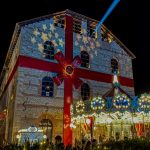Pyrgos village
 The homeland of Chalepas, Nikiforos Lytras and Giannis Gaitis, surrounded by the mountain peaks Patela, Meroviglia, Profitis Ilias and Kaki Scala, was at its great prime during the 18th and 19th century, while the exploitation of marble deposits of the area began. Walking down Giannoulis Chalepas Str.) that passes from Panormos’ Artists’ Museum and Giannoulis Chalepas’ house, you will see blazons, “portosies”, doorsteps, fountains, inscriptions, busts, alleys and carved tables, everything made of marble. Continue till the central, marble paved square (of the Heroes of 1821) with the shady plane, the monumental fountains and the coffee-pastry shops and visit the Museum of Marble Crafts of the Cultural Foundation of Piraeus.
The homeland of Chalepas, Nikiforos Lytras and Giannis Gaitis, surrounded by the mountain peaks Patela, Meroviglia, Profitis Ilias and Kaki Scala, was at its great prime during the 18th and 19th century, while the exploitation of marble deposits of the area began. Walking down Giannoulis Chalepas Str.) that passes from Panormos’ Artists’ Museum and Giannoulis Chalepas’ house, you will see blazons, “portosies”, doorsteps, fountains, inscriptions, busts, alleys and carved tables, everything made of marble. Continue till the central, marble paved square (of the Heroes of 1821) with the shady plane, the monumental fountains and the coffee-pastry shops and visit the Museum of Marble Crafts of the Cultural Foundation of Piraeus.
Panormos village
 The northeast shore of Tinos houses the seaport of Pyrgos (22 miles from Chora). In the center of the bay, the Planitis islet and its ruined lighthouse complete the picture perfect scenery of the scenic sea village. From the 70’s and on, the once small fishery village began to get touristic progress, resulting today to be considered the most significant holiday settlement of the area. In the beautiful port, there are fish-taverns for the fresh fish and seafood lovers but also cafes for relaxation with view to the moored fishing boats and yachts.
The northeast shore of Tinos houses the seaport of Pyrgos (22 miles from Chora). In the center of the bay, the Planitis islet and its ruined lighthouse complete the picture perfect scenery of the scenic sea village. From the 70’s and on, the once small fishery village began to get touristic progress, resulting today to be considered the most significant holiday settlement of the area. In the beautiful port, there are fish-taverns for the fresh fish and seafood lovers but also cafes for relaxation with view to the moored fishing boats and yachts.
Isternia village
 Isternia village, the birthplace of marble artisans, is situated on the slopes of Meroviglia Mountain, above the Isternia bay, at an altitude of approximately 1000 feet. Great sculptors, like Fytalai and Malakate brothers, Georgios Vitalis, Lazaros Lameras, Antonis and Lefteris Sochos had thrived here. You can admire their artworks in the Ysternian Artists’ Museum which operates inside the old school.
Isternia village, the birthplace of marble artisans, is situated on the slopes of Meroviglia Mountain, above the Isternia bay, at an altitude of approximately 1000 feet. Great sculptors, like Fytalai and Malakate brothers, Georgios Vitalis, Lazaros Lameras, Antonis and Lefteris Sochos had thrived here. You can admire their artworks in the Ysternian Artists’ Museum which operates inside the old school.
Volax village
 A place reminiscent of an eerie, lunar-like scenery. One may think that Titanomachy has truly taken place in the plateau with the enormous round granite boulders. The gigantic pellets in the vast tract which surrounds Volax village in Kato Meria constitute a unique geological phenomenon worldwide and are accredited to meteorites’ fall. The views on this issue vary, with some people to believe that this once was the bottom of the sea and others to claim that the rocks derived from volcanic eruption millions of years ago.
A place reminiscent of an eerie, lunar-like scenery. One may think that Titanomachy has truly taken place in the plateau with the enormous round granite boulders. The gigantic pellets in the vast tract which surrounds Volax village in Kato Meria constitute a unique geological phenomenon worldwide and are accredited to meteorites’ fall. The views on this issue vary, with some people to believe that this once was the bottom of the sea and others to claim that the rocks derived from volcanic eruption millions of years ago.
Triantaros village
 Built amphitheatrically on a hill that “looks” at Aghios Fokas, it is rightly called “balcony of Tinos”. From every corner, the view is magical, even if it about the sea or the valley with the dovecots, which is spread on its feet. Go through the innumerable arches and see the church of the Holy Apostles, but also the traditional oil mill in Lefkes.
Built amphitheatrically on a hill that “looks” at Aghios Fokas, it is rightly called “balcony of Tinos”. From every corner, the view is magical, even if it about the sea or the valley with the dovecots, which is spread on its feet. Go through the innumerable arches and see the church of the Holy Apostles, but also the traditional oil mill in Lefkes.
Tripotamos village
 Upon visiting Tripotamos, the philosopher Cornelius Castoriadis was so enchanted by the old arches, the long stairways and the dazzling arcades, that he declared it to be his second homeland. When you’ve finished exploring the village, take a little culinary break in order to try the renowned, locally produced, Tinian cheese.
Upon visiting Tripotamos, the philosopher Cornelius Castoriadis was so enchanted by the old arches, the long stairways and the dazzling arcades, that he declared it to be his second homeland. When you’ve finished exploring the village, take a little culinary break in order to try the renowned, locally produced, Tinian cheese.
Dio Choria village

Once upon a time, the green slopes of Kechrovouni mountain used to house two little villages, separated only by a river. As the years passed and the residents multiplied, the two communities were joined to form Dio Choria. At an altitude of 1500 feet, it is one of the most popular scenic viewpoints of Tinos, offering panoramic views of the vastness of the Aegean Sea, Chora and even Naxos, when the sky is clear. The village itself will amaze you with medieval arches, the old narrow streets, the natural fountains and the perennial sycamore tree in the center of the square which will lure you under its shadow, where you will be taken away by a breathtaking view.
Xinara village
 The heart of Catholicism on the island beats in Xinara, on the outskirts of Xobourgo. The seat of the Catholic Archdiocese of Tinos is here, under the imposing rock, while here is the Bishop’s Palace, which was converted from a seminary into a church museum, and the Virgin of the Rosary (Cathedral Catholic Archdiocese).
The heart of Catholicism on the island beats in Xinara, on the outskirts of Xobourgo. The seat of the Catholic Archdiocese of Tinos is here, under the imposing rock, while here is the Bishop’s Palace, which was converted from a seminary into a church museum, and the Virgin of the Rosary (Cathedral Catholic Archdiocese).
Loutra village
 The destruction of the castle marked the founding of monasteries of the Jesuits monks and the Ursulines nuns in Loutra village, transforming the area into the most important religious center of Tinos. In this small village of Kato Meria, in the year 1862 the monastery of Ursulines was founded by a nun of the convent. At the same time a female school with orphanage, primary and junior high school began to run. Nowadays it has been converted into museum, where visitors can admire musical instruments and handicrafts. The Jesuits monastery operates as an Agricultural museum.
The destruction of the castle marked the founding of monasteries of the Jesuits monks and the Ursulines nuns in Loutra village, transforming the area into the most important religious center of Tinos. In this small village of Kato Meria, in the year 1862 the monastery of Ursulines was founded by a nun of the convent. At the same time a female school with orphanage, primary and junior high school began to run. Nowadays it has been converted into museum, where visitors can admire musical instruments and handicrafts. The Jesuits monastery operates as an Agricultural museum.
Kardiani village
 The first settlement in Exo Meria in the southwest part of the island sets upon the steep hillside of Pateles mountain, in an altitude of 240m, with view to Syros. Surrounded by intense vegetation and many springs, it boasts for the arcades, the catholic church of Holy Mary’s Birthday-Kioura and higher for the orthodox one of Trinity, with the one and only arch of six arches in Cyclades.
The first settlement in Exo Meria in the southwest part of the island sets upon the steep hillside of Pateles mountain, in an altitude of 240m, with view to Syros. Surrounded by intense vegetation and many springs, it boasts for the arcades, the catholic church of Holy Mary’s Birthday-Kioura and higher for the orthodox one of Trinity, with the one and only arch of six arches in Cyclades.







